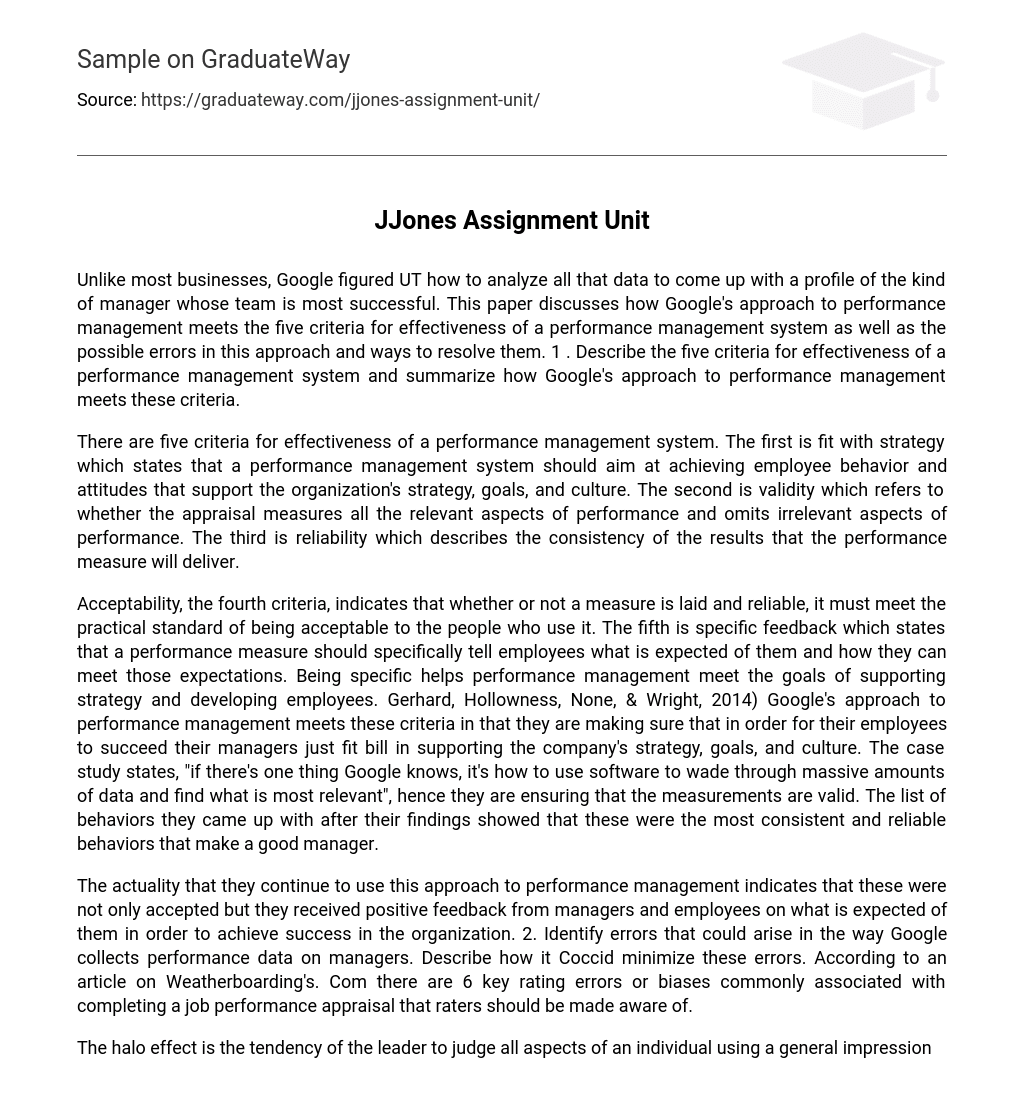Unlike most businesses, Google figured UT how to analyze all that data to come up with a profile of the kind of manager whose team is most successful. This paper discusses how Google’s approach to performance management meets the five criteria for effectiveness of a performance management system as well as the possible errors in this approach and ways to resolve them. 1 . Describe the five criteria for effectiveness of a performance management system and summarize how Google’s approach to performance management meets these criteria.
There are five criteria for effectiveness of a performance management system. The first is fit with strategy which states that a performance management system should aim at achieving employee behavior and attitudes that support the organization’s strategy, goals, and culture. The second is validity which refers to whether the appraisal measures all the relevant aspects of performance and omits irrelevant aspects of performance. The third is reliability which describes the consistency of the results that the performance measure will deliver.
Acceptability, the fourth criteria, indicates that whether or not a measure is laid and reliable, it must meet the practical standard of being acceptable to the people who use it. The fifth is specific feedback which states that a performance measure should specifically tell employees what is expected of them and how they can meet those expectations. Being specific helps performance management meet the goals of supporting strategy and developing employees. Gerhard, Hollowness, None, & Wright, 2014) Google’s approach to performance management meets these criteria in that they are making sure that in order for their employees to succeed their managers just fit bill in supporting the company’s strategy, goals, and culture. The case study states, “if there’s one thing Google knows, it’s how to use software to wade through massive amounts of data and find what is most relevant”, hence they are ensuring that the measurements are valid. The list of behaviors they came up with after their findings showed that these were the most consistent and reliable behaviors that make a good manager.
The actuality that they continue to use this approach to performance management indicates that these were not only accepted but they received positive feedback from managers and employees on what is expected of them in order to achieve success in the organization. 2. Identify errors that could arise in the way Google collects performance data on managers. Describe how it Coccid minimize these errors. According to an article on Weatherboarding’s. Com there are 6 key rating errors or biases commonly associated with completing a job performance appraisal that raters should be made aware of.
The halo effect is the tendency of the leader to judge all aspects of an individual using a general impression that as formed on only one or a few of the individual’s characteristics. The contrast error occurs when a leader compares subordinates with one another instead of against performance standards. The regency bias occurs where a leader assigns ratings based only on the employee’s most recent performance rather than the employee’s performance over the entire period being rated. The leniency bias occurs where a leader is too soft or too generous when rating the employee’s performance.
This is often due to manager discomfort with giving an honest rating. The severity bias occurs when a leader is too hard or harsh when rating their employee’s performance. The self serving bias occurs when the leader tends to perceive that they were personally responsible for success and others were responsible for failure. (weatherboarding’s. Com, 2009) Not all raters rate the same, hence the aforementioned errors can occur in the way Google collects performance data on managers. To avoid or minimize these errors, “raters can be trained how to avoid rating errors. ” (Gerhard et al. 2014) This can be done via requiring “prospective raters attach videos whose scripts or storyline are designed to lead them to make specific rating errors. After rating the fictional employees in the videos, raters discuss their rating decisions and how such errors affected their rating decisions. Training programs offer tips for avoiding the errors in the future. ” (Gerhard et al. , 2014) 3. Describe the steps or activities that might be involved in Google’s performance management process. According to the Case Study, the company distilled its findings into a list of the behaviors that get results: 1.
Be a good coach. 2. Empower your team. Do not micromanage. 3. Express interest in team members’ success and personal well-being. 4. Don’t be a sissy: Be productive and results-oriented. 5. Be a good communicator, and listen to your team. 6. Help your employees with career development. 7. Have a clear vision and strategy for the team. 8. Have key technical skills so you can help advise the team. Google was able to evaluate its managers’ performance and identify those who needed to improve in particular areas.





